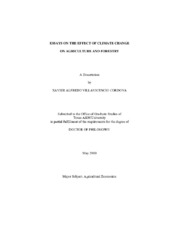| dc.description.abstract | In this dissertation, I study the effects of climate change on agricultural total
factor productivity and crop yields and their variability. In addition, an examination was
conducted on the value of select climate change adaptation strategies in forestry. Across
the study, the climate change scenarios analyzed were based on the 2007
Intergovernmental Panel on Climate Change Assessment Report.
Climate change impacts on the returns to research investments were examined
extending the work of Huffman and Evenson (2006), incorporating climatic effects. The
conjecture is that the rate of return of agricultural research is falling due to altered
resource allocations and unfavorable weather conditions, arising from the early onset of
climate change. This work was done using a panel model of Agricultural Total Factor
Productivity (TFP) for the forty-eight contiguous states over 1970?1999. Climatic
variables such as temperature and amount and intensity of precipitation were added into
the model. The main results are (1) climate change affects research productivity, varying by region; (2) this effect is generally negative; (3) additional investments are needed to
achieve pre-climate change TFP rates of growth; and (4) the predicted investment
increases are on the order of 18%.
The second inquiry involved the impact of historical climatic conditions on the
statistical distributions of crop yields through mean and variability. This was done
statistically, using historical yields for several crops in the US, and climate variables,
with annual observations from 1960 to 2007. The estimation shows that climate change
is having an effect on the first two moments of the distribution, concluding that crop
yield distributions are not stationary. The implication is that risk analysis must consider
means and volatility measures that depend on future climatic conditions. The analysis
shows that future mean yields will increase, but volatility will also be greater for the
studied crops. These results have strong implication for future crop insurance decisions.
Finally, an examination was done on the value of select forestry adaptation
strategies in the face of climate change. This work is motivated by the known fact that
forestry sector is already heavily adapted to changing climatic conditions. Using the
Forestry and Agriculture Sector Optimization Model for the United States (FASOM), I
found that rotation age is the most effective adaptation strategy being worth about 60
billion dollars, while changes in species and management intensity are worth about 1.5
billion, and land use change between forestry to agriculture is worth about 200,000. | en |


